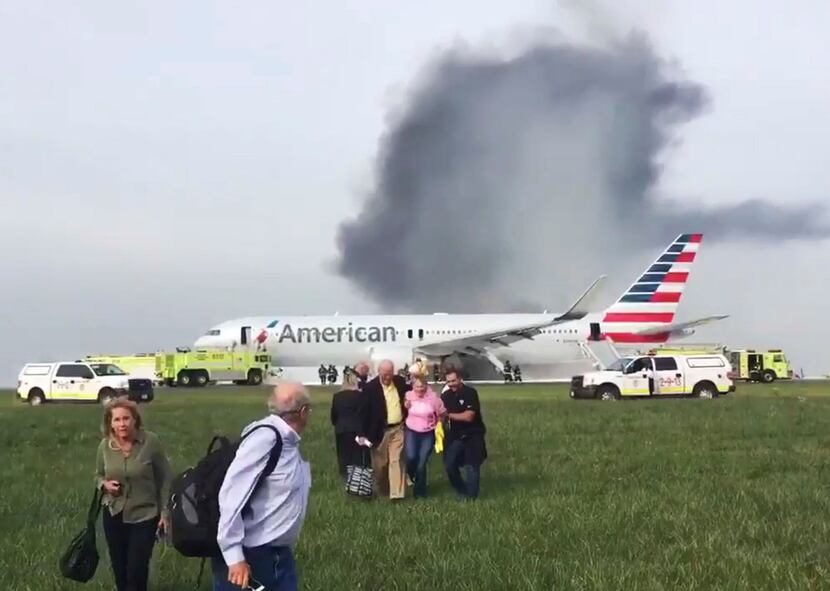On Oct. 28, 2016, American Airlines Flight 383 sped down the runway at Chicago’s O’Hare International Airport for a flight to Miami when the Boeing 767 aircraft came to a sudden stop and a fire erupted around the right engine.
Within seconds, the plane’s flight attendants had begun to evacuate the plane, with the first passenger exiting down an overwing slide 31 seconds after the plane came to a stop.
Less than two minutes later, all 161 passengers on board were off the plane as the fire continued to burn.

But in those early moments as they went down the slide, the left engine was still spooling down, and the forceful jet blast knocked over a passenger on the tarmac, causing serious injuries.
“American Flight 383 came too close for comfort,” the NTSB’s chairman Robert Sumwalt said during a hearing about the accident, which also resulted in minor injuries to 20 others on the plane.
How passengers evacuate an aircraft during an emergency — and how crews are trained to conduct those evacuations — has been a recurring concern for the safety agency over the last two decades.
It’s a topic that is getting renewed attention this year with the release of two NTSB reports investigating accidents that had evacuation-related issues and the launch of an audit by a federal watchdog.
At the request of federal lawmakers, the Department of Transportation’s Office of the Inspector General launched an audit this summer to study Federal Aviation Administration evacuation standards that haven’t been significantly updated since 1990, according to the inspector general.
Of particular interest is how air travel has changed in the decades since many of the safety rules were put in place, with more densely packed aircraft, tighter seats and more passengers carrying on baggage, which some dangerously try to take with them as they evacuate during emergencies.
“A lot of this fits into the natural evolution of safety standards; we need to always be examining the results of what happens,” said Mark Millam, vice president at the nonprofit Flight Safety Foundation. “Are we getting more successful at passenger evacuations?”
Phone trouble
As the American Airlines Flight 383 evacuation unfolded, a flight attendant attempted to call the cockpit on the plane’s interphone system to alert them about the running engine but pressed the wrong numbers.
Another couldn’t remember how to use the phone, which varies between airplane types, and the NTSB could not determine whether a third had difficulty reaching the cockpit using the phone or failed to place the call entirely.
Similar problems with phone systems were encountered on an American A330 flying out of London in June 2016 that was evacuated at the gate when smoke began to fill the cockpit, according to a report from British aviation authorities.
In its investigation of the Chicago incident, the NTSB noted the two different phone models on older and newer 767 aircraft, and more broadly, that key layouts are not standardized across systems. The agency also said recurring training for flight attendants lacked hands-on practice with the phones.
Concerns about flight attendant-pilot communications were raised by the NTSB as far back as 2009, when it called on the FAA to update guidance and training for flight crews during emergencies.
Communication issues were identified in three other 2015 evacuations, two of which were started while engines were still running.
An FAA spokesman said that updated guidance on evacuation communication has been drafted and is undergoing review, with plans to publish by the end of this year after a public comment period.
American Airlines has incorporated lessons from the 2016 incidents in Chicago and London into its training on aircraft phones, spokeswoman Michelle Mohr said. The company has a flight safety task force that continuously reviews and updates training and safety practices, she said.
“That event did highlight certain impediments in intercrew communication,” she said. “We never stop learning. Any kind of an event or incident, assessments are made and changes are made as appropriate.”
Evacuation standards
Emergency evacuations have also been under scrutiny in the long-running battle over shrinking airline seats, with the consumer group Flyers Rights petitioning and eventually suing the FAA on claims that current standards don’t account for modern cabin conditions.
The FAA sets standards for minimum aisle widths and exit sizes, emergency lighting and exit sign placement, and the number and location of exits.
These contribute to the ultimate test for aircraft evacuation certification: Can it be unloaded of passengers in an emergency in 90 seconds or less?
Live drills are conducted and filmed by plane manufacturers with paid volunteer passengers who don’t know when the evacuation will begin.
Flyers Rights challenged the results of these tests, arguing that they don’t account for the narrower distances between seats and the added girth of the average passenger in 2018.
Although the group initially found some support from an appellate court judge last year who ordered a review by the FAA in what she dubbed as the “case of the incredible shrinking airline seat,” the FAA released a report in July refuting many of Flyers Rights’ claims and said it does not plan to take further action to regulate seat sizes.
In its report, the FAA said that exiting a seat typically takes passengers only a few seconds — even with a cramped 28 inches between rows.
“The FAA continues to regard the issues and requested actions from your petition as having a lower priority than the other issues before the FAA,” the agency wrote in its report. “Given the FAA's limited rulemaking resources, those resources will be dedicated to higher priorities.”
Leave the luggage
Perhaps the greatest evacuation-related concern by airlines and safety regulators is the one they have the least control over: passenger behavior.
As a flight attendant ushered passengers off the 2016 American flight, one approached the exit with a carry-on bag in hand.
The attendant tried to take the bag away, but the passenger refused, and the flight attendant realized that the struggle was delaying others from evacuating the burning aircraft. The passenger continued down the emergency slide. At all three exits used during the evacuation, passengers tried to exit with carry-on bags, according to the NTSB.
“Things can be replaced. People can’t. Pilots and flight attendants need your cooperation, as a passenger, to perform safe and orderly evacuation,” the NTSB’s Sumwalt said.
Industry officials have also seen a troubling rise in people taking pictures, video or posting on social media during emergency situations.
“Get off the plane as fast as possible,” said Mohr, the American Airlines spokeswoman. “And don’t be taping it because you’re slowing down the evacuation and putting human lives at risk.”

